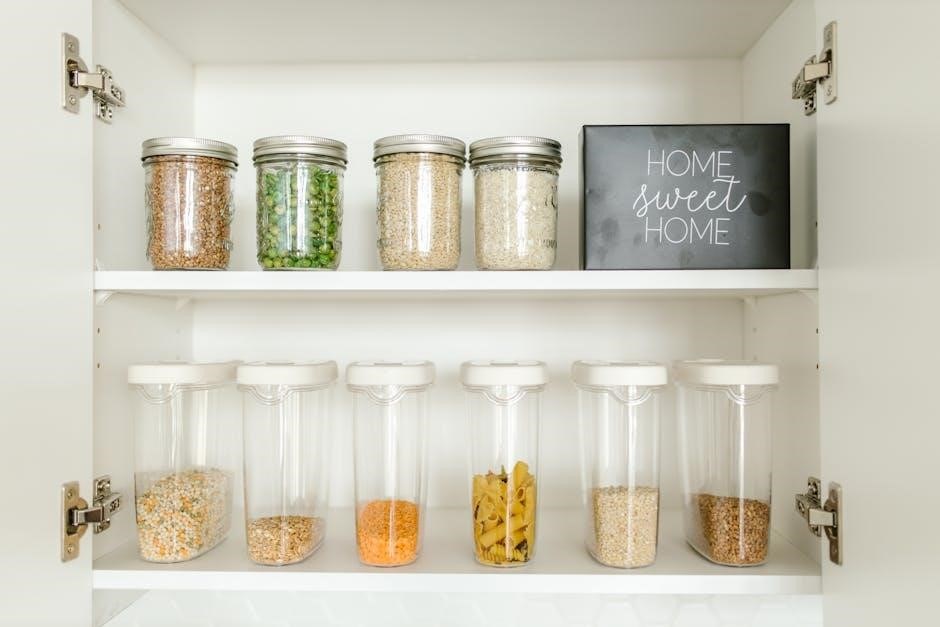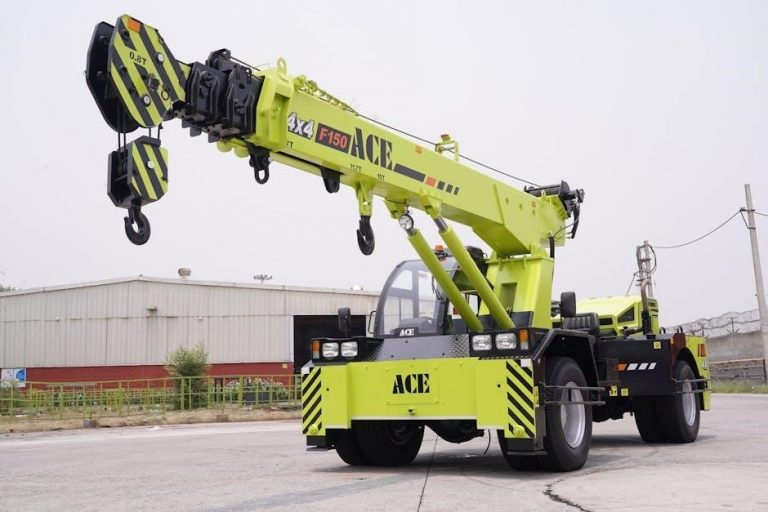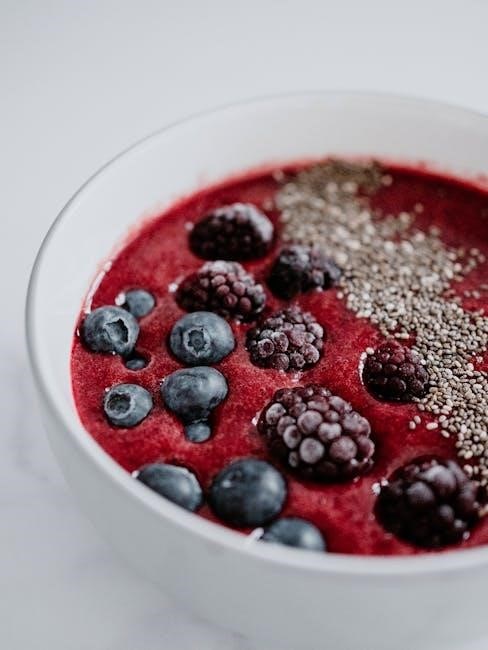Kitchen cabinet specifications are detailed guidelines ensuring functionality and aesthetics. They cover dimensions, materials, hardware, and construction standards, crucial for designing and installing cabinets effectively in any kitchen space.
1.1 Overview of Kitchen Cabinet Specifications
Kitchen cabinet specifications outline the requirements for design, materials, and construction. They include standard dimensions, such as base, wall, and tall cabinets, ensuring compatibility and functionality. Materials range from wood to laminates, with finishes like paint or stain. Hardware specifications, including hinges and drawer slides, are also covered. These guidelines ensure cabinets meet quality, safety, and durability standards, adhering to industry benchmarks like those set by the Kitchen Manufacturers Association (KCMA). Proper specifications guarantee a kitchen’s aesthetic and functional needs are met.
1.2 Importance of Kitchen Cabinet Specifications
Kitchen cabinet specifications are essential for ensuring functionality, durability, and aesthetic appeal. They provide clear guidelines for materials, dimensions, and construction, guaranteeing cabinets fit seamlessly into the space. Adhering to standards like KCMA ensures quality and safety. Proper specifications prevent installation issues and costly rework. They also guide material selection, from wood types to finishes, ensuring cabinets align with design goals. By meeting these criteria, cabinets offer long-term performance and satisfaction, making them a critical element in kitchen design and functionality.
Standard Kitchen Cabinet Dimensions
Standard kitchen cabinet dimensions ensure uniformity and functionality. Base cabinets typically range from 34.5 to 36 inches in height, while wall cabinets are 30 to 42 inches tall. Depths vary between 12 to 24 inches, accommodating various designs and spaces. Drawer fronts and shelves are tailored to fit these measurements, ensuring seamless integration and practical use in modern kitchens.
2.1 Base Cabinet Dimensions
Base cabinets are foundational elements in kitchen design, typically measuring 34.5 to 36 inches in height, including the countertop. Depths range from 24 inches, standard for storage, to 12 inches for narrower spaces. Widths vary in 3-inch increments, with common sizes being 12, 18, 24, 30, 36, and 42 inches. These dimensions ensure functionality and fit, accommodating drawers, shelves, and appliances. Proper sizing is essential for a balanced layout, ensuring alignment with countertops and ease of access for everyday use;
2.2 Wall Cabinet Dimensions
Wall cabinets typically range in height from 30 to 42 inches, with depths usually around 12 inches to fit standard wall configurations. Widths vary in 3-inch increments, common sizes being 12, 18, 24, 30, 36, and 42 inches. Heights often align with base cabinets for visual balance, while depths ensure they don’t obstruct kitchen workflow. Proper sizing ensures they fit above countertops or appliances, providing ample storage while maintaining accessibility. These dimensions are standardized to complement kitchen layouts and maximize vertical space efficiently.
2.3 Tall Cabinet Dimensions
Tall cabinets, often used for pantries or storage, typically range from 84 to 96 inches in height to maximize vertical space. Widths vary in 3-inch increments, commonly 12, 18, 24, 30, 36, and 42 inches. Depths are usually around 12 inches to maintain kitchen workflow. These cabinets are ideal for storing bulk items, cookware, or less frequently used goods. Customizable features like adjustable shelves or pull-out drawers enhance functionality, making tall cabinets a practical choice for efficient kitchen organization and space utilization.
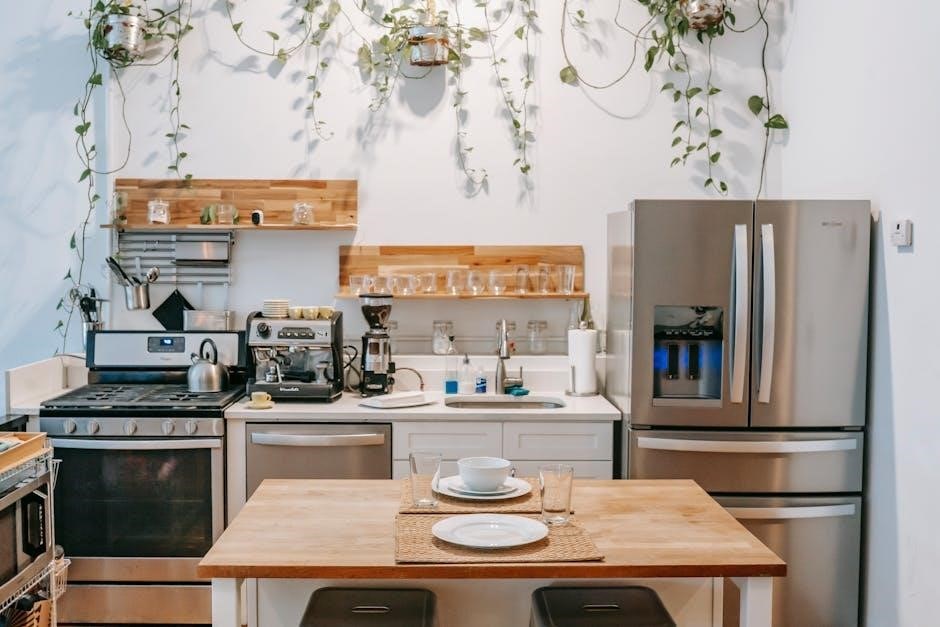
Kitchen Cabinet Materials and Finishes
Kitchen cabinets are crafted from materials like wood, MDF, or laminate, offering durability and style. Finishes include paint, stain, or thermofoil, enhancing aesthetics and functionality.
3.1 Types of Wood Used for Cabinets
Kitchen cabinets often use wood species like oak, maple, cherry, and hickory, each offering unique grain patterns and durability. Oak is durable with a pronounced grain, while maple features a light, even texture. Cherry wood is prized for its rich color and fine grain, and hickory is known for its strength and rustic appeal. Pine is another option, offering a softer, knotty look. The choice of wood depends on desired aesthetics, durability, and budget, ensuring a balance between style and functionality in kitchen designs.
3.2 Laminate and Thermofoil Finishes
Laminate and thermofoil finishes are popular for kitchen cabinets due to their durability and aesthetic appeal. Laminate finishes are made from layers of resin and paper, offering a wide range of colors and patterns. They are cost-effective and resistant to scratches and fading. Thermofoil finishes, on the other hand, are vinyl sheets molded to cabinet doors using heat. They provide a smooth, glossy appearance and are highly resistant to moisture, making them ideal for modern, low-maintenance kitchens.
3.3 Painted and Stained Finishes
Painted and stained finishes offer a classic, customizable look for kitchen cabinets. Painted finishes provide a smooth, uniform appearance, while stained finishes enhance the natural beauty of the wood grain. Both options are durable and can be tailored to match various design styles. Painted finishes are ideal for modern, monochromatic looks, while stained finishes suit traditional or rustic kitchens. Proper application ensures longevity, with painted finishes being more prone to wear over time compared to stained ones, which can be easily touched up.
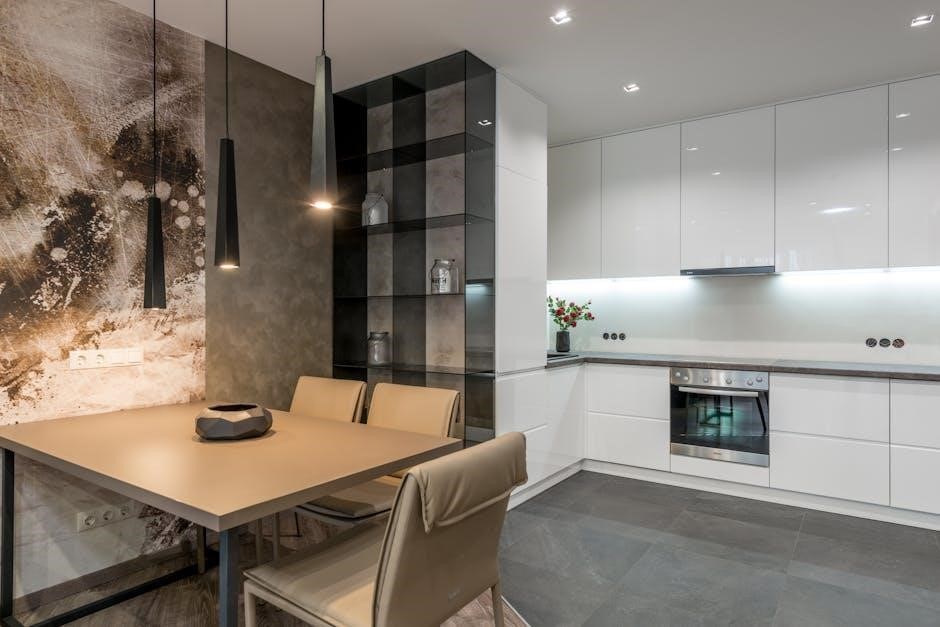
Kitchen Cabinet Hardware Specifications
Hardware specifications are crucial for functionality and aesthetics. Hinges, drawer slides, handles, and knobs must be durable, ensuring smooth operation and complementing the cabinet design effectively.
4.1 Hinges and Drawer Slides
Hinges and drawer slides are essential for smooth cabinet operation. Hinges come in types like soft-close or concealed, ensuring doors shut quietly and durably. Drawer slides, such as ball-bearing or roller systems, offer effortless gliding and weight capacity. High-quality hardware enhances longevity and usability, with features like adjustable hinges for alignment and silent drawer closure mechanisms. Proper specification ensures seamless functionality and aesthetic appeal, making these components vital in kitchen cabinet design.
4.2 Door Handles and Knobs
Door handles and knobs are crucial for both functionality and aesthetics. They come in various styles, such as bar pulls, knobs, or bow handles, made from materials like stainless steel, brass, or glass. Choosing the right finish ensures durability and aligns with the kitchen’s design. Ergonomic designs provide comfort and ease of use, while decorative options enhance visual appeal. Proper specification ensures handles and knobs complement the cabinet’s overall look and functionality, creating a cohesive and user-friendly kitchen space.
4.3 Soft-Close Mechanisms
Soft-close mechanisms ensure drawers and doors close smoothly and quietly without slamming. These systems, often integrated into hinges and drawer slides, use hydraulic dampers or spring mechanisms to control motion. They enhance durability by reducing wear and tear from harsh closures. Soft-close features are especially beneficial in busy kitchens, minimizing noise and preventing accidental damage. Proper installation and adjustment are critical to ensure optimal performance. This feature is a modern convenience that improves user experience and extends cabinet lifespan, making it a valuable specification for kitchen cabinets.
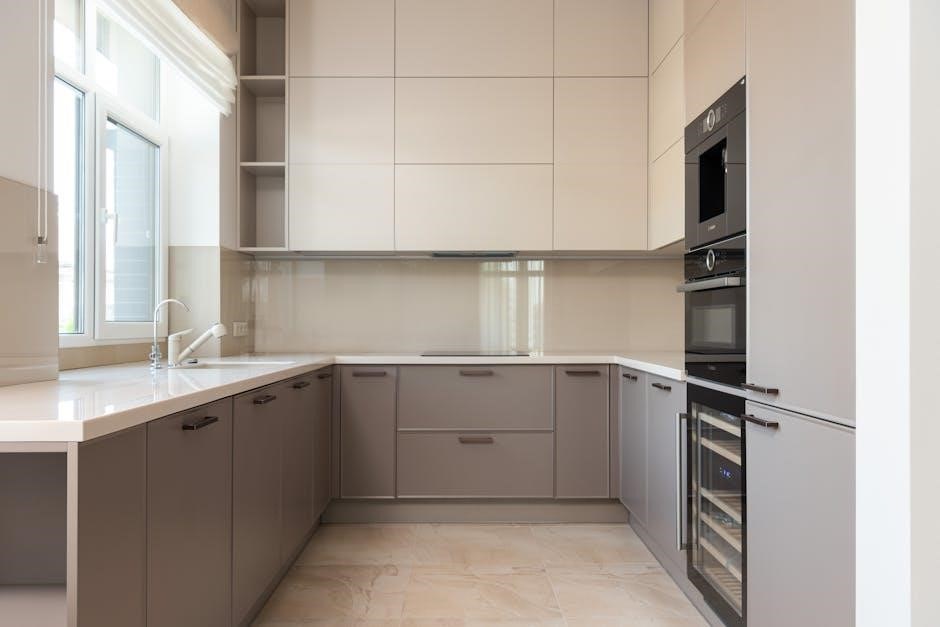
Kitchen Cabinet Styles and Designs
Kitchen cabinet styles vary widely, from modern minimalism to traditional elegance. Designs incorporate materials, finishes, and hardware, offering aesthetic and functional solutions for diverse kitchen spaces and preferences.
5.1 Modern vs. Traditional Cabinet Styles
Modern cabinet styles emphasize minimalism, clean lines, and sleek finishes, often featuring handle-less doors or subtle hardware. They incorporate materials like glass, metal, and lacquered surfaces for a contemporary look. In contrast, traditional styles focus on ornate details, raised panels, and classic designs, often using solid wood and timeless finishes. The choice between modern and traditional depends on the desired aesthetic and functionality of the kitchen space, with each style offering unique design elements to enhance the overall interior. Both cater to different tastes and architectural preferences.
5.2 Frameless vs. Framed Cabinets
Frameless cabinets lack a face frame, offering a sleek, modern appearance and maximizing interior space. They are constructed with thicker sides and bottoms for durability. Framed cabinets, conversely, feature a face frame for added structural support and a traditional look. Frameless designs are ideal for contemporary kitchens, while framed cabinets suit classic or rustic settings. Both options are durable but differ in style and functionality, catering to varied design preferences and storage needs in kitchen spaces.
5.3 Custom vs. Stock Cabinets
Custom cabinets are tailored to specific kitchen layouts and design preferences, offering unlimited style and size options. They are built to exact measurements, ensuring a perfect fit. Stock cabinets, however, are pre-made and mass-produced, providing cost-effective solutions with limited customization. Custom cabinets are ideal for unique spaces or high-end designs, while stock cabinets are budget-friendly and quickly available. Both options balance quality and affordability, catering to different needs and preferences in kitchen renovations and designs.
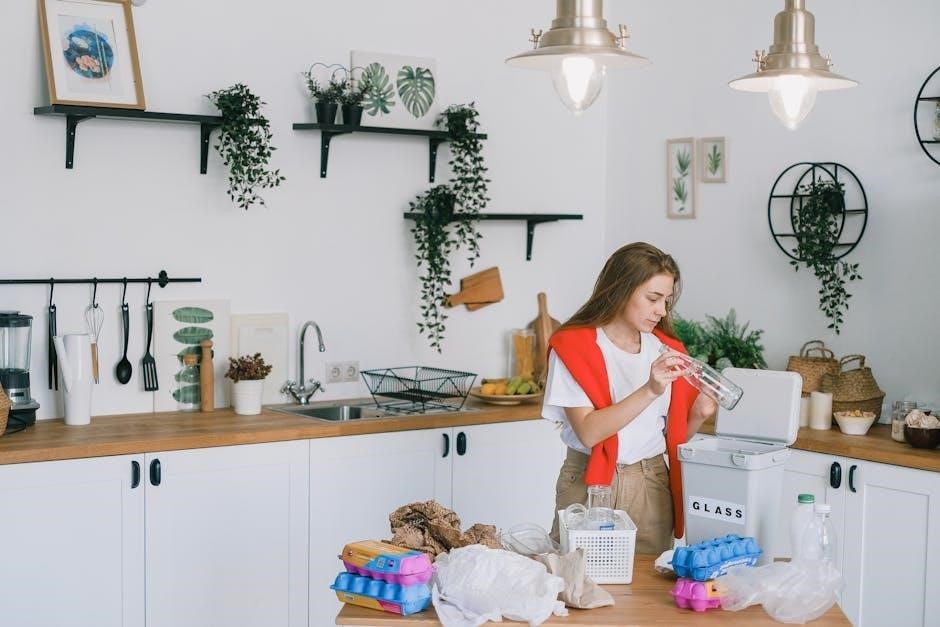
Kitchen Cabinet Construction and Quality Standards
Kitchen cabinet construction involves durable materials and precise manufacturing to ensure longevity and stability, meeting industry quality standards for both residential and commercial applications.
6.1 Plywood vs. MDF Construction
Plywood and MDF are common materials for kitchen cabinets, each offering unique benefits. Plywood, made from layered wood veneers, is durable and resistant to warping, ideal for structural components. MDF, composed of wood fibers bonded with resin, is denser and smoother, suitable for painted finishes. Plywood is heavier and more moisture-resistant, while MDF is more cost-effective and less prone to wood grain imperfections. Choosing between them depends on budget, desired finish, and environmental conditions, ensuring optimal performance and aesthetics for kitchen cabinets.
6.2 Drawer Construction and Durability
Drawer construction plays a key role in kitchen cabinet functionality and longevity. High-quality drawers often feature sturdy materials like solid wood or MDF, paired with durable drawer slides, such as soft-close or ball-bearing mechanisms. Joints like dovetail or staple construction enhance strength and stability. The use of reinforced bottoms and smooth-gliding tracks ensures consistent performance. Proper finishing, such as sealing or painting, protects against wear and moisture. Durable drawers withstand heavy use, making them a critical factor in kitchen cabinet specifications for long-lasting performance and satisfaction.
6.3 Certifications and Compliance
Certifications and compliance are essential for ensuring kitchen cabinets meet quality, safety, and environmental standards. Look for certifications like KCMA (Kitchen Cabinet Manufacturers Association), which ensures durability and safety. CARB (California Air Resources Board) compliance verifies low formaldehyde emissions. ISO certifications demonstrate adherence to environmental management standards. Compliance with local building codes and regulations is also crucial. These standards ensure cabinets are safe, eco-friendly, and durable, providing consumers with confidence in their purchase while meeting legal and environmental requirements.
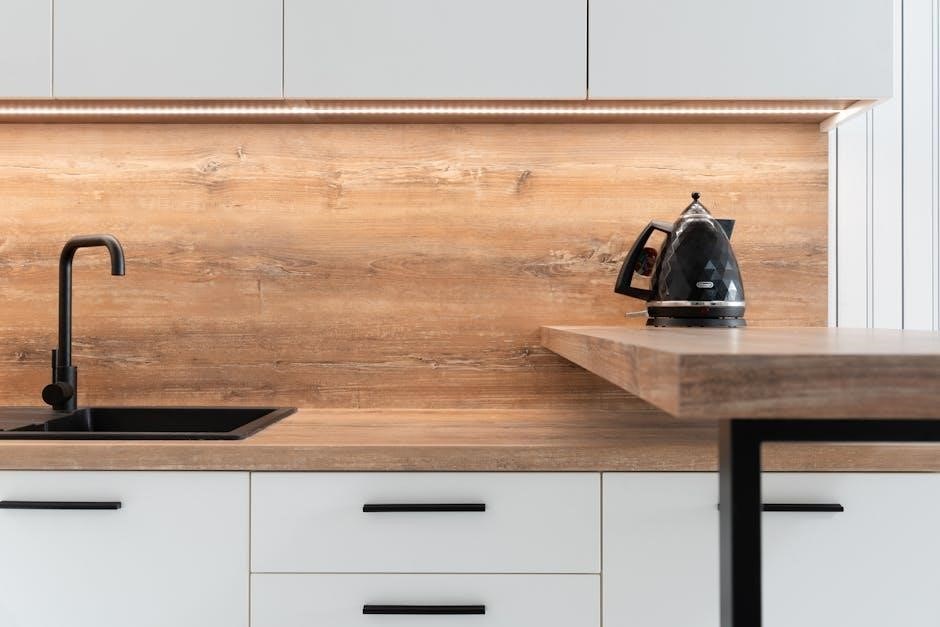
Kitchen Cabinet Accessories and Features
Kitchen cabinet accessories enhance functionality with features like drawer organizers, adjustable shelves, and wine racks, improving storage and accessibility for a more organized kitchen space.
7.1 Pull-Out Shelves and Drawers
Pull-out shelves and drawers enhance kitchen efficiency by providing easy access to stored items. Constructed from durable materials like metal or wood, they feature smooth-gliding mechanisms, often with soft-close functionality. These accessories are customizable to fit specific needs, offering adjustable dividers or compartments. They maximize space utilization, allowing seamless retrieval of cookware, utensils, or pantry goods. High-quality pull-outs are built to withstand heavy loads, ensuring longevity. Proper installation ensures alignment and stability, making them a practical addition to modern kitchen designs.
7.2 Spice Racks and Tray Dividers
Spice racks and tray dividers are essential kitchen cabinet accessories for organization. Spice racks, often adjustable, store spices, oils, or condiments, keeping them visible and accessible. Tray dividers, meanwhile, separate items like baking sheets, cutting boards, or serving trays, preventing clutter. Made from materials like wood, metal, or plastic, these features maximize storage efficiency. Customizable sizes and finishes ensure they blend seamlessly with cabinet designs. They enhance functionality by optimizing vertical space and maintaining order, making cooking and meal prep more convenient and enjoyable.
7.3 Lighting Options for Cabinets
Lighting options for cabinets enhance functionality and aesthetics. LED lighting is popular for its energy efficiency and brightness. Options include under-cabinet lighting, interior lighting, and toe-kick lighting. Puck lights, strip lights, and motion-sensor lights are common choices. These solutions provide ambient or task lighting, improving visibility. Hardwired or battery-operated options cater to different needs. Lighting can highlight design features, creating a modern look. Proper installation ensures safety and durability. Choose lighting that complements cabinet style and kitchen decor for a cohesive, functional space.
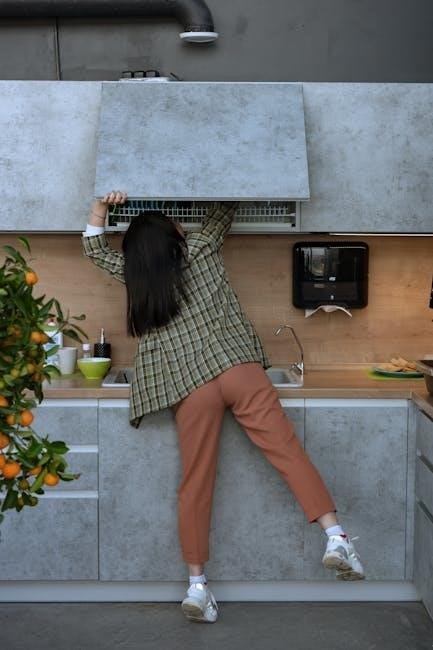
Kitchen Cabinet Installation Requirements
Proper installation ensures stability and functionality. Key requirements include wall anchoring, leveling, and alignment. Plumbing and electrical setups must be considered for appliances and lighting. Safety codes must be followed.
8.1 Wall Anchoring and Support
Proper wall anchoring is crucial for kitchen cabinet stability and safety. Cabinets must be securely fastened to wall studs using screws or brackets to prevent tipping. Ensure weight distribution is even, and anchors are rated for the cabinet’s load. Double-check stud locations to avoid weak points. Use heavy-duty hardware like lag screws or toggle bolts for added support. Anchoring systems should comply with local building codes to guarantee durability and safety over time.
8.2 Leveling and Alignment
Proper leveling and alignment are essential for a professional kitchen cabinet installation. Use a spirit level or laser level to ensure all cabinets are perfectly horizontal and vertical. Adjust the cabinet legs or shims to achieve even alignment, preventing doors and drawers from misaligning. Double-check the plumb lines to maintain structural integrity. Misalignment can lead to functional issues and aesthetic imperfections. Ensure all units are flush with adjacent cabinets for a seamless look. Follow manufacturer guidelines for precise leveling to guarantee optimal performance and longevity of the cabinets.
8.3 Plumbing and Electrical Considerations
When installing kitchen cabinets, ensure proper plumbing and electrical setups are considered. Water supply lines and drains should be accessible near sinks and dishwashers. Electrical outlets for appliances must be strategically placed to avoid interference with cabinet doors or drawers. Avoid routing wires or pipes behind cabinets, as this can cause damage or restrict access. Install GFCI outlets near water sources for safety. Plan layouts to comply with local building codes and safety standards. Consult professionals if unsure to prevent costly rework or hazards.
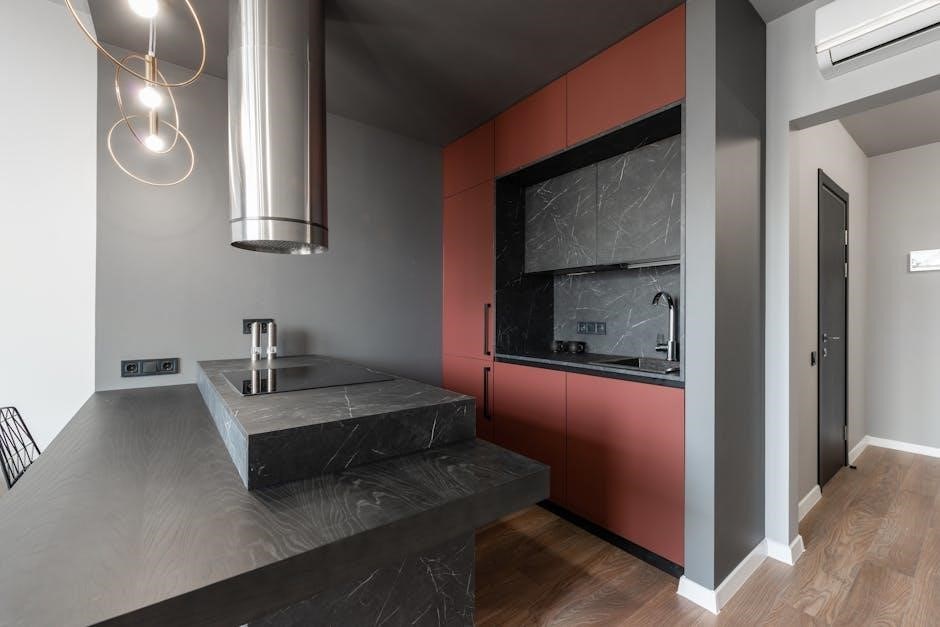
Kitchen Cabinet Maintenance and Care
Regular cleaning, avoiding moisture exposure, and prompt repair of damage are essential for maintaining kitchen cabinets. Proper care ensures longevity and preserves their aesthetic appeal.
9.1 Cleaning and Sanitizing Cabinets
Regular cleaning is crucial for maintaining kitchen cabinets. Use a mild detergent and warm water for wood surfaces, while laminate or thermofoil cabinets may require specialized cleaners. Avoid harsh chemicals or abrasive materials that can damage finishes. Sanitize high-touch areas like handles with a diluted bleach solution. Dry surfaces thoroughly to prevent water spots or moisture damage. For painted or stained cabinets, avoid excessive water, as it may harm the finish. Wipe down shelves and drawers regularly, especially in high-use areas. Address spills immediately to prevent stains or warping. Quarantine items before storing to ensure cleanliness and prevent pests. Frequent cleaning ensures durability and hygiene. Always test cleaning products on a small, inconspicuous area first to avoid damage. For tough stains, gently scrub with a soft cloth. Avoid using paper towels, which can leave lint. Regular sanitizing keeps cabinets germ-free, essential for a healthy kitchen environment. Cleaning schedules should be tailored to usage levels, with daily wipe-downs in busy kitchens. Never use bleach on natural wood, as it can cause discoloration. Store cleaning supplies in an accessible location for quick cleanups. Teach all household members proper cleaning techniques to maintain cabinet condition. Cleaning should be done from top to bottom to prevent dirt from spreading. Use microfiber cloths for effective cleaning without streaks. Avoid spraying cleaning products directly on cabinets; instead, apply them to a cloth first. For glass doors, use glass cleaner and a lint-free cloth to avoid streaks. Clean drawer tracks and hinges regularly to ensure smooth operation. Sanitize drawer interiors, especially if storing food. Always rinse cleaning cloths thoroughly to prevent detergent buildup. Avoid using steam cleaners, as they can damage finishes or warp materials. For persistent odors, use baking soda or activated charcoal inside cabinets. Clean cabinet handles with a disinfectant wipe daily. Never leave dirty dishes or utensils in cabinets, as they can attract pests. Regular cleaning prevents grease buildup, which can be difficult to remove over time. Use a degreaser for areas around cooking stations. Clean light fixtures inside cabinets to maintain brightness and hygiene. Never use abrasive scrubbers, as they can scratch surfaces. For stubborn grease, mix baking soda and water to create a paste, apply it, and wipe clean. Clean the tops of cabinets to remove dust and allergens. Use a step stool or ladder safely when cleaning hard-to-reach areas. Teach children to handle cabinets gently to avoid fingerprints and scratches. Clean cabinets before and after major holidays or events when the kitchen is heavily used. Never neglect the backs of cabinets, as dust and debris can accumulate. Clean the cabinet frames and doors separately for thorough maintenance. Avoid using too much water, as it can seep into joints and cause swelling. Use a clean, dry cloth to wipe down cabinets after cleaning to remove excess moisture. Regular cleaning prevents the need for deep cleaning, saving time and effort. For custom cabinets, follow the manufacturer’s cleaning instructions to maintain warranties. Clean cabinets in sections to avoid missing spots. Use a damp cloth to wipe down shelves and drawers, then dry them immediately. Avoid placing wet items in cabinets, as they can cause moisture damage. Clean cabinet knobs and handles with a soft brush to remove dust and grime. Use a gentle polish for metal hardware to maintain its shine. For painted cabinets, avoid using wax or silicone-based products, as they can leave residue; Clean the edges and corners of cabinets, where dust and crumbs often accumulate. Use a vacuum cleaner with a soft brush attachment to remove debris from tight spaces. Clean the inside of cabinet doors, especially if they have vents or decorative panels. Avoid using aerosol cleaners, as they can leave a residue or damage finishes. Clean cabinets in a well-ventilated area to avoid inhaling fumes from cleaning products. For eco-friendly cleaning, use vinegar and water for most cabinet surfaces. Clean up spills immediately to prevent them from hardening or staining. Use a clean, dry cloth to blot spills; never rub, as it can damage the finish. For cabinets with glass inserts, clean the glass from both sides to avoid streaks. Use a squeegee for large glass surfaces to remove excess water. Clean the hinges and drawer slides with a dry cloth to remove grease and dust. For soft-close hinges, clean the mechanisms gently to ensure smooth operation. Use a small, clean brush to remove dust from intricate carvings or moldings. Clean the tops of wall cabinets to remove dust and cobwebs. For open-shelf cabinets, clean each item and the shelves regularly to maintain appearance. Use a cleaning caddy with all necessary supplies to make the process efficient. Clean cabinets in a consistent pattern, such as top to bottom and left to right, to ensure thoroughness. For high-gloss cabinets, use a cleaner specifically designed for high-gloss surfaces to maintain their shine. Clean the kickspace area below cabinets to remove dust and debris. Use a handheld vacuum or small brush to clean tight spaces. For cabinets with lighting, clean the light fixtures and surrounding areas to maintain brightness. Avoid using rough cloths or scrubbers that can scratch or dull the finish. Clean the inside of drawers, especially if they store food or utensils. Use drawer liners to protect the interior and make cleaning easier. Clean the edges of shelves to remove dust and crumbs. For adjustable shelves, clean the tracks and supports to ensure proper alignment. Use a clean, dry cloth to wipe down cabinet handles and knobs. For cabinets with locks, clean the keyholes and handles to ensure smooth operation. Clean the inside of cabinet doors, especially if they have shelves or compartments. Use a soft-bristle brush to clean decorative trim or molding. For cabinets with crown molding, clean the top edges to remove dust and debris. Use a clean, damp cloth to wipe down the entire exterior of the cabinets. Avoid using too much cleaner, as it can leave a residue. Clean the cabinets in sections, such as all the base cabinets first, then the wall cabinets. Use a step ladder safely when cleaning tall cabinets. Clean the back of wall cabinets to remove dust and debris. For corner cabinets, clean the carousel or lazy Susan to ensure smooth rotation. Use a clean, dry cloth to wipe down the exterior of pull-out shelves. Clean the inside of spice racks and tray dividers to remove dust and crumbs. Use a small, clean brush to remove dust from tight spaces. For cabinets with lighting, clean the light bulbs and fixtures to maintain brightness. Avoid using paper towels, as they can leave lint behind. Clean the inside of cabinets before storing food or dishes to ensure cleanliness. Use a clean, damp cloth to wipe down shelves and drawers. Avoid using bleach on natural wood cabinets, as it can cause discoloration. For painted cabinets, avoid using abrasive cleaners that can scratch the paint. Clean the inside of cabinets regularly to prevent pest infestations. Use a clean, dry cloth to wipe down the exterior of cabinets after cleaning. For cabinets with soft-close drawers, clean the mechanisms gently to ensure smooth operation. Clean the inside of cabinets before and after renovations or construction to remove dust and debris. Use a clean, damp cloth to wipe down the shelves and drawers. Avoid using too much water, as it can damage the materials. Clean the inside of cabinets to remove any strong odors or smells. Use baking soda or activated charcoal to absorb odors. Clean the inside of drawers, especially if they store food or utensils. Use drawer liners to protect the interior and make cleaning easier. For cabinets with adjustable shelves, clean the tracks and supports to ensure proper alignment. Use a clean, dry cloth to wipe down the exterior of cabinets. Avoid using harsh chemicals that can damage the finish. Clean the inside of cabinets to remove dust and debris. Use a vacuum cleaner with a soft brush attachment to remove dust and crumbs. For high-gloss cabinets, use a cleaner specifically designed for high-gloss surfaces. Avoid using wax or silicone-based products on painted cabinets. Clean the inside of cabinets before storing items to ensure cleanliness. Use a clean, damp cloth to wipe down shelves and drawers. For cabinets with crown molding, clean the top edges to remove dust and debris. Use a clean, dry cloth to wipe down the exterior of cabinets. Avoid using abrasive scrubbers that can scratch the finish. For custom cabinets, follow the manufacturer’s cleaning instructions to maintain warranties. Clean the inside of cabinets to prevent pest infestations. Use a clean, dry cloth
9.2 Avoiding Damage from Moisture
Moisture can severely damage kitchen cabinets, causing warping, swelling, or mold. To prevent this, ensure proper ventilation in the kitchen, especially near sinks and dishwashers. Use water-resistant materials like plywood or MDF with moisture-proof coatings. Regularly inspect for leaks and address them promptly. Avoid placing wet items directly on surfaces; use towels or mats instead. Ensure cabinets are sealed properly to prevent moisture infiltration. Clean up spills immediately and dry surfaces thoroughly. Install moisture barriers in humid areas and maintain good air circulation to reduce humidity levels. This helps preserve the integrity and longevity of your cabinets.
9.3 Touch-Up and Repair Tips
Regular touch-ups and repairs can extend the life of your kitchen cabinets. For minor scratches, use touch-up pens or markers that match the cabinet finish. Deeper scratches or dents may require filling with wood filler, sanding, and repainting or restaining. Inspect hardware regularly; tighten loose knobs or handles. Clean cabinets with a mild detergent and water to prevent grime buildup. Avoid harsh chemicals that could damage finishes. Address chips or peeling paint promptly to prevent further damage. Proper maintenance ensures your cabinets remain durable and visually appealing over time.
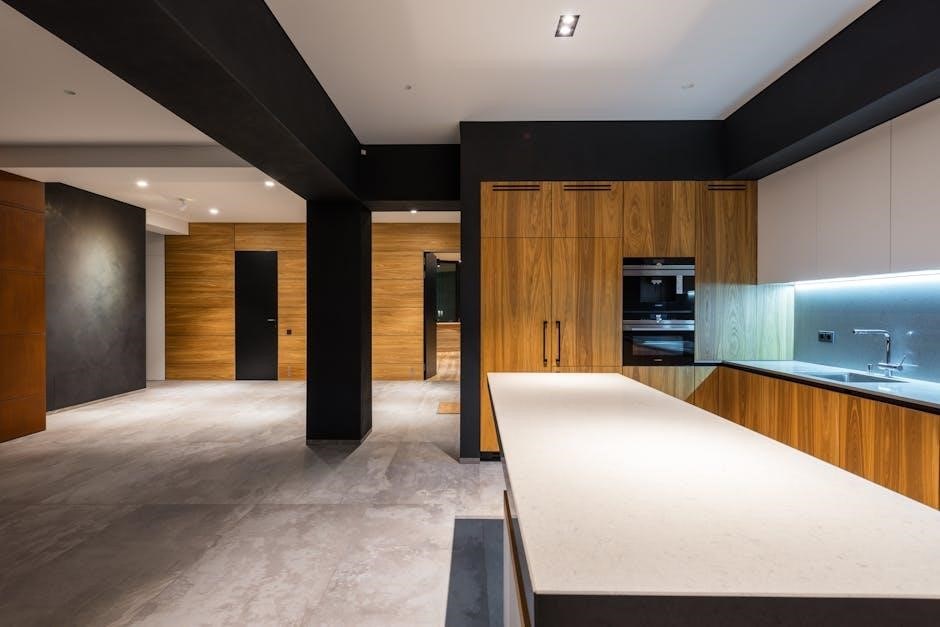
Common Mistakes to Avoid in Kitchen Cabinet Specifications
- Incorrectly measuring spaces can lead to poor fit and functionality.
- Overlooking material quality often results in durability issues.
- Ignoring hardware specifications can compromise performance and aesthetics.
- Failing to plan for storage needs leads to inefficiency.
- Neglecting future trends limits design adaptability.
10.1 Incorrect Measurements
Incorrect measurements are a common mistake in kitchen cabinet specifications, leading to poor fit and functionality; Measurements must account for wall angles, flooring, and ceiling heights to ensure proper alignment. Failure to consider door swing space or drawer depth can disrupt workflow. Double-checking dimensions for base, wall, and tall cabinets is essential. Even slight mismeasurements can cause installation issues or require costly adjustments. Accurate measurements ensure cabinets complement the kitchen layout and meet user needs effectively, avoiding rework and delays.
10.2 Overlooking Material Quality
Overlooking material quality in kitchen cabinet specifications can lead to durability and aesthetic issues. Using low-grade materials like thin plywood or low-density MDF may result in warping or damage over time. High-quality materials, such as solid wood or dense plywood, ensure longevity and stability. Finishes and coatings also play a role in moisture resistance and appearance. Neglecting material quality can compromise the cabinet’s structural integrity and visual appeal, making it essential to prioritize durable and suitable materials for the kitchen environment.
10.3 Ignoring Hardware Specifications
Ignoring hardware specifications can compromise the functionality and longevity of kitchen cabinets. Low-quality hinges, drawer slides, and handles may lead to premature wear and tear. Poorly designed mechanisms can affect the smooth operation of doors and drawers. Additionally, outdated or incompatible hardware can hinder the overall performance and durability of the cabinets. Proper hardware specifications ensure optimal functionality, ease of use, and lasting durability, making it crucial to prioritize them during the planning phase.
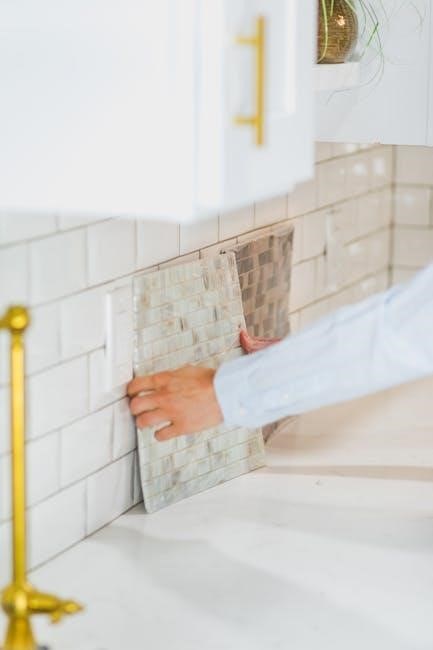
Kitchen Cabinet Trends and Innovations
Modern kitchen cabinets emphasize smart technology integration, sustainable materials like bamboo or recycled content, and customizable designs. Eco-friendly options and modular systems are gaining popularity for functionality and aesthetics.
11.1 Smart Cabinets and Technology Integration
Smart cabinets are revolutionizing kitchen design with integrated technology. Features like touchless controls, LED lighting, and charging stations enhance functionality. Advanced locking systems and app-controlled security add convenience and safety. Some cabinets include sensors for inventory management, while others incorporate voice-activated opening systems. These innovations streamline kitchen workflows, improving efficiency and user experience. As technology evolves, smart cabinets are becoming a staple in modern kitchens, offering a blend of style, convenience, and cutting-edge functionality for homeowners seeking a futuristic culinary space.
11.2 Sustainable and Eco-Friendly Cabinets
Sustainable and eco-friendly cabinets are made from responsibly sourced materials like bamboo, recycled wood, or FSC-certified lumber. These cabinets often feature low-VOC finishes and adhesives, improving indoor air quality. Energy-efficient manufacturing processes and recyclable components reduce environmental impact. Some cabinets incorporate reclaimed wood or eco-friendly composites. Certifications like Greenguard Gold ensure adherence to strict environmental standards. Eco-conscious designs also focus on durability and longevity, reducing the need for frequent replacements. Sustainable cabinets align with modern eco-friendly lifestyles, offering a guilt-free alternative for environmentally aware homeowners.
11.3 Color and Design Trends
Current kitchen cabinet trends emphasize neutral tones like white, cream, and gray, offering a clean, timeless aesthetic. Bold, bright colors are also gaining popularity for adding personality. Two-tone designs, with contrasting upper and lower cabinets, create visual interest. Modern styles feature minimalist lines, slab doors, and handle-less options, while traditional designs incorporate ornate details. Rustic and vintage looks are also in demand, blending classic charm with modern functionality. Open shelving and glass-front cabinets are popular for a sleek, airy feel. Customization allows homeowners to mix finishes and styles for a unique kitchen environment.
